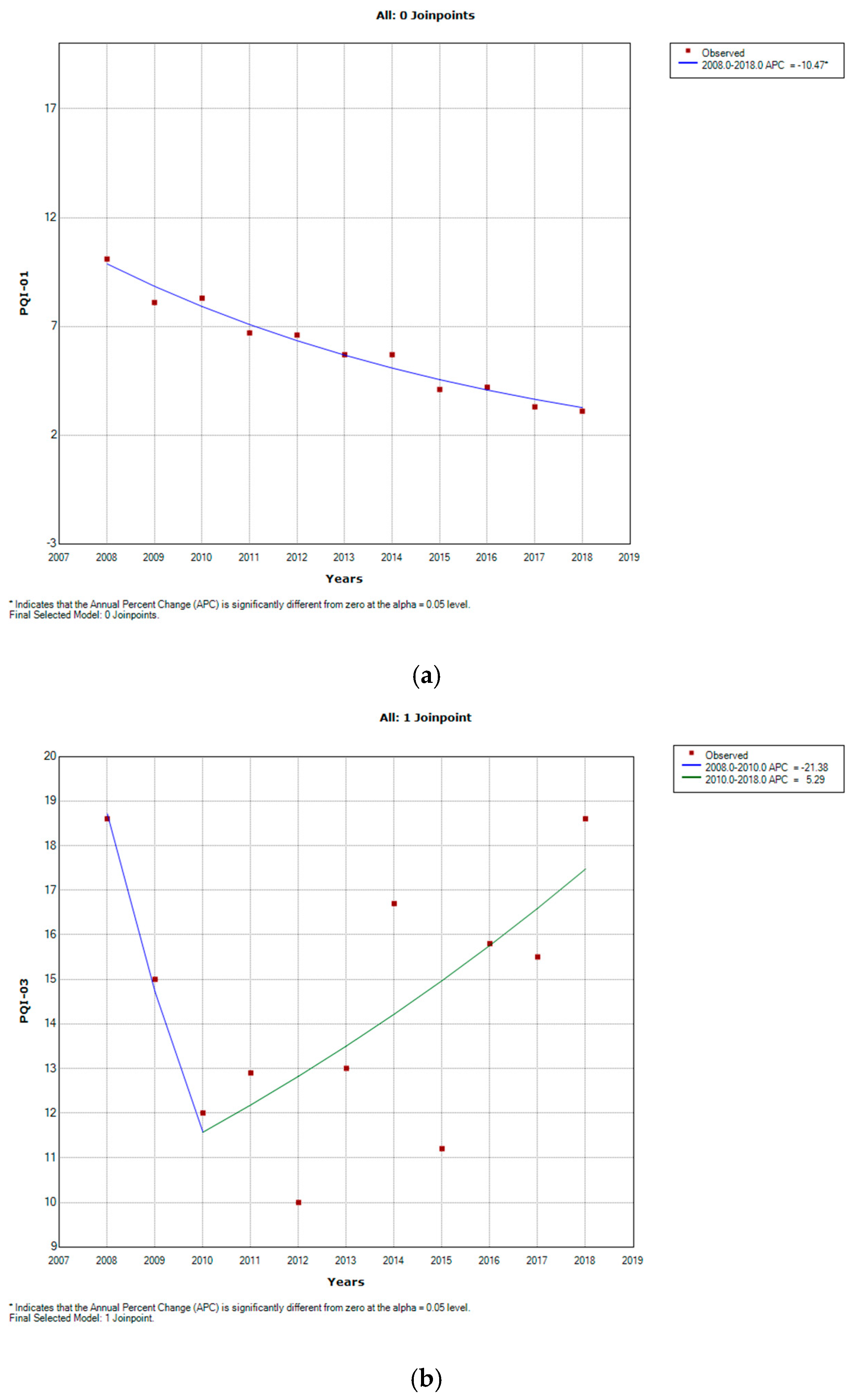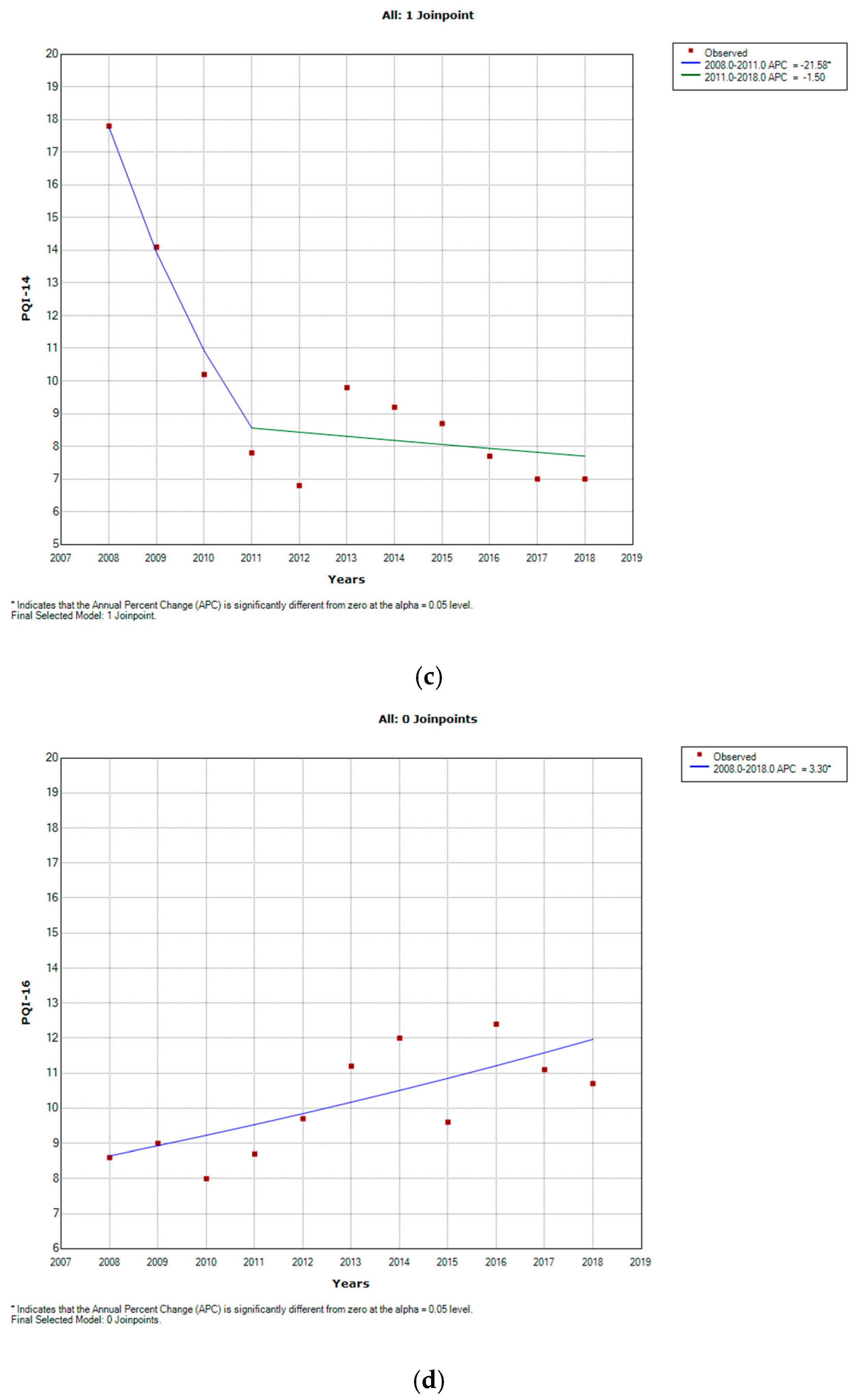The Burden of Diabetes-Related Preventable Hospitalization: 11-Year Trend and Associated Factors in a Region of Southern Italy
Abstract
1. Introduction
2. Materials and Methods
2.1. Study Design
2.2. Ethical Approval
2.3. Statistical Analysis
3. Results
3.1. Characteristics of Admissions
3.2. Trend in PQIs Admissions
3.3. Factors Associated with PQIs
4. Discussion
Strengths and Limitations
5. Conclusions
Author Contributions
Funding
Institutional Review Board Statement
Informed Consent Statement
Data Availability Statement
Acknowledgments
Conflicts of Interest
References
- American Diabetes Association. Economic costs of diabetes in the U.S. in 2017. Diabetes Care 2018, 41, 917–928. [Google Scholar] [CrossRef] [PubMed]
- Emerging Risk Factors Collaboration; Sarwar, N.; Gao, P.; Seshasai, S.R.K.; Gobin, R.; Kaptoge, S.; Di Angelantonio, E.; Ingelsson, E.; Lawlor, D.A.; Stampfer, M.; et al. Diabetes mellitus, fasting blood glucose concentration, and risk of vascular disease: A collaborative meta-analysis of 102 prospective studies. Lancet 2010, 375, 2215–2222. [Google Scholar] [PubMed]
- IDF Diabetes Atlas. Available online: https://www.idf.org/e-library/epidemiology-research/diabetes-atlas/19-atlas-6th-edition.html (accessed on 5 February 2020).
- Van Loenen, T.; Faber, M.J.; Westert, G.P.; Van den Berg, M.J. The impact of primary care organization on avoidable hospital admissions for diabetes in 23 countries. Scand. J. Prim. Health Care 2016, 34, 5–12. [Google Scholar] [CrossRef]
- Kringos, D.S.; Boerma, W.G.; Hutchinson, A.; Van Der Zee, J.; Groenewegen, P.P. The breadth of primary care: A systematic literature review of its core dimensions. BMC Health Serv Res. 2010, 10, 65. [Google Scholar] [CrossRef] [PubMed]
- Gibson, O.R.; Segal, L.; McDermott, R.A. A systematic review of evidence on the association between hospitalisation for chronic disease related ambulatory care sensitive conditions and primary health care resourcing. BMC Health Serv. Res. 2013, 13, 336. [Google Scholar] [CrossRef] [PubMed]
- Rosano, A.; Loha, C.A.; Falvo, R.; Van Der Zee, J.; Ricciardi, W.; Guasticchi, G.; de Belvis, A.G. The relationship between avoidable hospitalization and accessibility to primary care: A systematic review. Eur. J. Public Health 2013, 23, 356–360. [Google Scholar] [CrossRef]
- Saultz, J.W.; Lochner, J. Interpersonal continuity of care and care outcomes: A critical review. Ann. Fam. Med. 2005, 3, 159–166. [Google Scholar] [CrossRef]
- AHRQ Quality Indicators Guide to Prevention Quality Indicators: Hospital Admission for Ambulatory Care Sensitive Conditions. 2001. Available online: www.ahrq.gov (accessed on 5 February 2020).
- Quan, H.; Sundararajan, V.; Halfon, P.; Fong, A.; Burnand, B.; Luthi, J.C.; Saunders, L.D.; Beck, C.A.; Feasby, T.E.; Ghali, W.A. Coding algorithms for defining comorbidities in ICD-9-CM and ICD-10 administrative data. Med. Care 2005, 43, 1130–1139. [Google Scholar] [CrossRef]
- Deyo, R.A.; Cherkin, D.C.; Ciol, M.A. Adapting a clinical comorbidity index for use with ICD-9-CM administrative databases. J. Clin. Epidemiol. 1992, 45, 613–619. [Google Scholar] [CrossRef]
- Istituto Superiore di Sanità. Il Diabete in Abruzzo. Available online: https://www.epicentro.iss.it/igea/raccolta/Allegati/abruzzo/Diabete_Abruzzo%20igea%202010.pdf) (accessed on 10 February 2021).
- Manzoli, L.; Flacco, M.E.; De Vito, C.; Arcà, S.; Carle, F.; Capasso, L.; Marzullio, C.; Muraglia, A.; Samani, F.; Villari, P. AHRQ prevention quality indicators to assess the quality of primary care of local providers: A pilot study from Italy. Eur. J. Public Health 2013, 24, 745–750. [Google Scholar] [CrossRef][Green Version]
- Ramalho, A.; Lobo, M.; Duarte, L.; Souza, J.; Santos, P.; Freitas, A. Landscapes on Prevention Quality Indicators: A Spatial Analysis of Diabetes Preventable Hospitalizations in Portugal (2016–2017). Int. J. Environ. Res. Public Health 2020, 17, 8387. [Google Scholar] [CrossRef]
- Di Martino, G.; Di Giovanni, P.; Cedrone, F.; Meo, F.; Scampoli, P.; Romano, F.; Staniscia, T. Hospitalization for Short-Term Diabetes-Related Complications: Focus on Patients Aged Over 85 Years. Healthcare 2021, 9, 460. [Google Scholar] [CrossRef]
- Fayfman, M.; Pasquel, F.J.; Umpierrez, G.E. Management of Hyperglycemic Crises: Diabetic Ketoacidosis and Hyperglycemic Hyperosmolar State. Med. Clin. N. Am. 2017, 101, 587–606. [Google Scholar] [CrossRef] [PubMed]
- Gurney, J.K.; Stanley, J.; Rumball-Smith, J.; York, S.; Sarfati, D. Postoperative Death After Lower-Limb Amputation in a National Prevalent Cohort of Patients with Diabetes. Diabetes Care 2018, 41, 1204–1211. [Google Scholar] [CrossRef] [PubMed]
- López-Valverde, M.E.; Aragón-Sánchez, J.; López-de-Andrés, A.; Guerrero-Cedeño, V.; Tejedor-Méndez, R.; Víquez-Molina, G.; Jiminez-Garcia, R. Perioperative and long-term all-cause mortality in patients with diabetes who underwent a lower extremity amputation. Diabetes Res. Clin. Pract. 2018, 141, 175–180. [Google Scholar] [CrossRef] [PubMed]
- Shen, Z.Z.; Huang, Y.Y.; Hsieh, C.J. Early short-term intensive multidisciplinary diabetes care: A ten-year follow-up of outcomes. Diabetes Res. Clin. Pract. 2017, 130, 133–141, . [Google Scholar] [CrossRef] [PubMed]
- Di Giovanni, P.; Meo, F.; Cedrone, F.; D’Addezio, M.; Di Martino, G.; Scampoli, P.; Valente, A.; Romano, F.; Staniscia, T. Predictors and Trend of Ketoacidosis Hospitalization Rate in Type 2 Diabetes Mellitus Patients from 2006 to 2015 in Abruzzo Region, Italy. Clin Ter. 2020, 170, e53–e58. [Google Scholar] [PubMed]
- Di Giovanni, P.; Scampoli, P.; Meo, F.; Cedrone, F.; D’Addezio, M.; Di Martino, G.; Valente, A.; Romano, F.; Staniscia, T. The impact of gender on diabetes-related lower extremity amputations: An Italian regional analysis on trends and predictors. Foot Ankle Surg. 2020, 27, 25–29. [Google Scholar] [CrossRef]
- Carinci, F.; Massi Benedetti, M.; Klazinga, N.S.; Uccioli, L. Lower extremity amputation rates in people with diabetes as an indicator of health systems performance. A critical appraisal of the data collection 2000–2011 by the Organization for Economic Cooperation and Development (OECD). Acta Diabetol. 2016, 53, 825–832. [Google Scholar] [CrossRef] [PubMed]
- Lombardo, F.L.; Maggini, M.; De Bellis, A.; Seghieri, G.; Anichini, R. Lower extremity amputations in persons with and without diabetes in Italy: 2001–2010. PLoS ONE 2014, 9, e86405. [Google Scholar] [CrossRef]
- Drab, S.R. Recognizing the rising impact of diabetes in seniors and implications for its management. Consult Pharm. 2009, 24 (Suppl. B), 5–10. [Google Scholar] [PubMed]
- Morgado, M.; Rolo, S.; Macedo, A.F.; Pereira, L.; Castelo-Branco, M. Predictors of uncontrolled hypertension and antihypertensive medication nonadherence. J. Cardiovasc. Dis. Res. 2010, 1, 196–202, . [Google Scholar] [CrossRef]
- Zhao, Y.; Xing, H.; Wang, X.; Ou, W.; Zhao, H.; Li, B.; Li, Y.; Duan, Y.; Zhuang, L.; Li, W.; et al. Management of Diabetes Mellitus in Patients with Chronic Liver Diseases. J. Diabetes Res. 2019, 2019, 6430486. [Google Scholar] [CrossRef] [PubMed]
- Thorud, J.C.; Plemmons, B.; Buckley, C.J.; Shibuya, N.; Jupiter, D.C. Mortality After Nontraumatic Major Amputation Among Patients with Diabetes and Peripheral Vascular Disease: A Systematic Review. J. Foot Ankle Surg. 2016, 55, 591–599. [Google Scholar] [CrossRef]
- Corrao, S.; Nobili, A.; Natoli, G.; Mannucci, P.M.; Perticone, F.; Pietrangelo, A.; Argano, C.; REPOSI Investigators. Hyperglycemia at admission, comorbidities, and in-hospital mortality in elderly patients hospitalized in internal medicine wards: Data from the RePoSI Registry. Acta Diabetol. 2021, 58, 1225–1236, . [Google Scholar] [CrossRef] [PubMed]


| N (%) | PQI-01 | PQI-03 | PQI-14 | PQI-16 |
|---|---|---|---|---|
| Total discharge | 1298 | 3217 | 1975 | 2170 |
| Male | 594 (45.76) | 1525 (47.40) | 955 (48.35) | 1092 (50.32) |
| Female | 704 (54.24) | 1692 (52.60) | 1020 (51.65) | 1078 (49.68) |
| Age category | ||||
| 18–34 | 158 (12.17) | 350 (10.88) | 227 (11.49) | 23 (10.69) |
| 35–44 | 123 (9.48) | 337 (10.48) | 204 (10.33) | 187 (8.62) |
| 45–54 | 166 (12.79) | 385 (11.97) | 234 (11.85) | 239 (11.01) |
| 55–64 | 170 (13.10) | 469 (14.58) | 280 (14.18) | 350 (16.13) |
| 65–74 | 255 (19.65) | 668 (20.76) | 405 (20.51) | 468 (21.57) |
| ≥75 | 426 (32.82) | 1008 (31.33) | 625 (31.65) | 694 (31.98) |
| Length of stay, median (IQR) | 8 (4–17) | 6 (3–11) | 7 (4–11) | 8 (4–15) |
| Discharge type | ||||
| At home | 1089 (83.90) | 2957 (91.92) | 1778 (90.03) | 1857 (85.58) |
| Long-term care facilities | 55 (4.24) | 37 (1.15) | 19 (0.96) | 91 (4.19) |
| Other | 24 (1.85) | 38 (1.18) | 25 (1.27) | 61 (2.81) |
| Death | 130 (10.02) | 185 (5.75) | 153 (7.75) | 161 (7.42) |
| Variables | PQI-01 | PQI-03 | PQI-14 | PQI-16 |
|---|---|---|---|---|
| aOR (95% CI) | aOR (95% CI) | aOR (95% CI) | aOR (95% CI) | |
| Male vs. Female | 0.93 (0.84–1.04) | 0.97 (0.40–0.83) | 1.03 (0.94–1.13) | 1.05 (0.96–1.15) |
| Age category | ||||
| 18–34 | 0.91 (0.73–1.13) | 0.86 (0.74–1.00) | 0.95 (0.79–1.15) | 0.90 (0.74–1.08) |
| 35–44 | 0.82 (0.65–1.04) | 0.96 (0.82–1.12) | 0.98 (0.81–1.19) | 0.84 (0.69–1.02) |
| 45–54 | REF. | REF. | REF. | REF. |
| 55–64 | 0.72 (0.58–0.89) | 0.85 (0.74–0.98) | 0.84 (0.70–1.00) | 0.98 (0.83–1.16) |
| 65–74 | 0.75 (0.62–0.92) | 0.83 (0.73–0.95) | 0.85 (0.72–1.00) | 0.93 (0.79–1.09) |
| >75 | 0.77 (0.64–0.92) | 0.79 (0.69–0.89) | 0.82 (0.70–0.96) | 0.86 (0.73–1.00) |
| Charlson Comorbidities | ||||
| IMA | 0.16 (0.07–0.34) | 0.24 (0.17–0.33) | 0.27 (0.16–0.43) | 0.47 (0.34–0.65) |
| CHF | 0.44 (0.33–0.58) | 0.24 (0.19–0.30) | 0.28 (0.21–0.37) | 0.26 (0.20–0.33) |
| Peripheral Vascular | 0.64 (0.43–0.93) | 15.51 (14.25–16.88) | 0.76 (0.57–1.02) | 5.05 (4.50–5.67) |
| Cerebro-vascular | 0.85 (0.70–1.02) | 0.46 (0.39–0.53) | 0.76 (0.65–0.90) | 0.42 (0.34–0.51) |
| Dementia | 1.73 (1.2 –2.35) | 0.91 (0.68–1.20) | 1.40 (1.06–1.85) | 0.52 (0.33–0.82) |
| COPD | 0.35 (0.26–0.46) | 0.28 (0.22–0.34) | 0.49 (0.40–0.60) | 0.56 (0.47–0.68) |
| Reumatic diseases | 0.64 (0.26–1.55) | 0.61 (0.33–1.13) | 1.56 (0.97–2.50) | 0.71 (0.33–1.52) |
| Peptic Ulcer | 0.88 (0.33–2.38) | 0.66 (0.32–1.37) | 0.40 (0.13–1.27) | 0.16 (0.02–1.20) |
| Hemi-paraplegia | 0.94 (0.35–2.54) | 0.20 (0.05–0.83) | 0.31 (0.07–1.25) | 0.19 (0.02–1.40) |
| Malignacy | 0.72 (0.50–1.03) | 0.37 (0.26–0.53) | 0.83 (0.63–1.10) | 0.37 (0.23–0.59) |
| Liver disease | 1.83 (1.48–2.26) | 0.91 (0.75–1.10) | 3.35 (2.93–3.84) | 0.28 (0.18–0.44) |
| Metastatic | 0.63 (0.37–1.09) | 0.02 (0.00–0.16) | 0.40 (0.23–0.68) | 0.10 (0.02–0.42) |
| AIDS/HIV | - | 2.19 (0.66–7.26) | 0.80 (0.11–5.90) | - |
| Renal disease | 0.87 (0.71–1.08) | 0.83 (0.73–0.96) | 0.80 (0.67–0.96) | 1.52 (1.35–1.71) |
Publisher’s Note: MDPI stays neutral with regard to jurisdictional claims in published maps and institutional affiliations. |
© 2021 by the authors. Licensee MDPI, Basel, Switzerland. This article is an open access article distributed under the terms and conditions of the Creative Commons Attribution (CC BY) license (https://creativecommons.org/licenses/by/4.0/).
Share and Cite
Di Martino, G.; Di Giovanni, P.; Cedrone, F.; D’Addezio, M.; Meo, F.; Scampoli, P.; Romano, F.; Staniscia, T. The Burden of Diabetes-Related Preventable Hospitalization: 11-Year Trend and Associated Factors in a Region of Southern Italy. Healthcare 2021, 9, 997. https://doi.org/10.3390/healthcare9080997
Di Martino G, Di Giovanni P, Cedrone F, D’Addezio M, Meo F, Scampoli P, Romano F, Staniscia T. The Burden of Diabetes-Related Preventable Hospitalization: 11-Year Trend and Associated Factors in a Region of Southern Italy. Healthcare. 2021; 9(8):997. https://doi.org/10.3390/healthcare9080997
Chicago/Turabian StyleDi Martino, Giuseppe, Pamela Di Giovanni, Fabrizio Cedrone, Michela D’Addezio, Francesca Meo, Piera Scampoli, Ferdinando Romano, and Tommaso Staniscia. 2021. "The Burden of Diabetes-Related Preventable Hospitalization: 11-Year Trend and Associated Factors in a Region of Southern Italy" Healthcare 9, no. 8: 997. https://doi.org/10.3390/healthcare9080997
APA StyleDi Martino, G., Di Giovanni, P., Cedrone, F., D’Addezio, M., Meo, F., Scampoli, P., Romano, F., & Staniscia, T. (2021). The Burden of Diabetes-Related Preventable Hospitalization: 11-Year Trend and Associated Factors in a Region of Southern Italy. Healthcare, 9(8), 997. https://doi.org/10.3390/healthcare9080997









